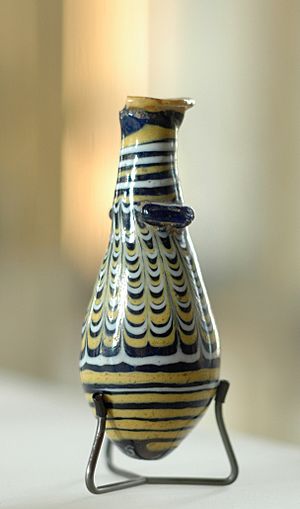Alabastron facts for kids

An alabastron is a small container, often made of pottery or glass. People in ancient times used them to hold special oils, like perfumes or massage oils. They first appeared in ancient Egypt around 1100 BC. Their name comes from the material they were often made from: a stone called alabaster. From Egypt, these cool little jars spread to ancient Greece and then to other parts of the classical world.
Contents
What is an Alabastron?
An alabastron is a small, usually tall and narrow, jar. It was designed to hold valuable liquids, especially oils used for perfumes or for massaging the body. Imagine a tiny bottle for your favorite scent – that's kind of what an alabastron was!
How Were They Designed?
Most alabastra had a slim body that was rounded at the bottom. They had a narrow neck and a wide, flared opening at the top. Many of them did not have handles. However, some types had small, ear-shaped bumps or lugs on the sides. Holes were poked through these lugs. This allowed people to string a cord through them, making the alabastron easy to carry around.
The very first alabastra from Egypt were inspired by the palm tree. They looked like a column with a palm tree top and a base. Later, people made alabastra from glass. These glass jars were decorated with different patterns, such as scallops, wavy lines, or abstract designs like rings and zigzags.
Alabastra in Ancient Greece
Around 700 BC, alabastra became popular in Greece. They became an important part of ancient Greek pottery. There were three main types of Greek alabastra:
- A basic, round shape from Corinth. These were about 3 to 4 inches (7.5 to 10 cm) tall. This design was very popular all over Greece.
- A long and pointed version. You could often find these in eastern Greek, Etruscan, and Italo-Corinthian pottery.
- An Attic type. These were about 4 to 8 inches (10 to 20 cm) long. They had a rounded bottom and the small lugs for carrying.
Beyond Greece
Alabastra also appeared in many other places in the ancient world. This included places like Assyria, Syria, and Palestine. It is thought that these jars were either inspired by or imported from Greece or Egypt.
About a hundred years after alabastra arrived in Greece, Greek artists started making fancy silver ones. These silver alabastra were long and narrow, usually about 12 to 16 cm (5 to 6 inches) tall. The decorations often divided the jar into four horizontal sections. These sections were separated by pretty bands around the body of the vase.
See also
 In Spanish: Alabastrón para niños
In Spanish: Alabastrón para niños

